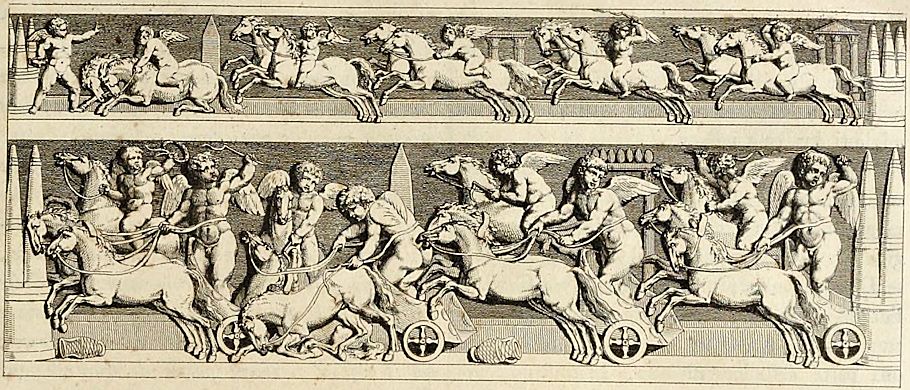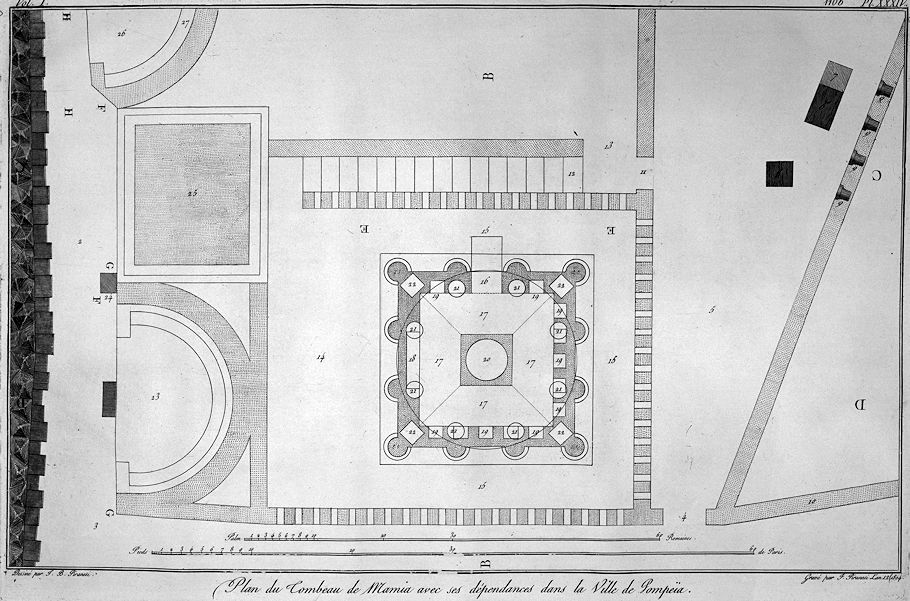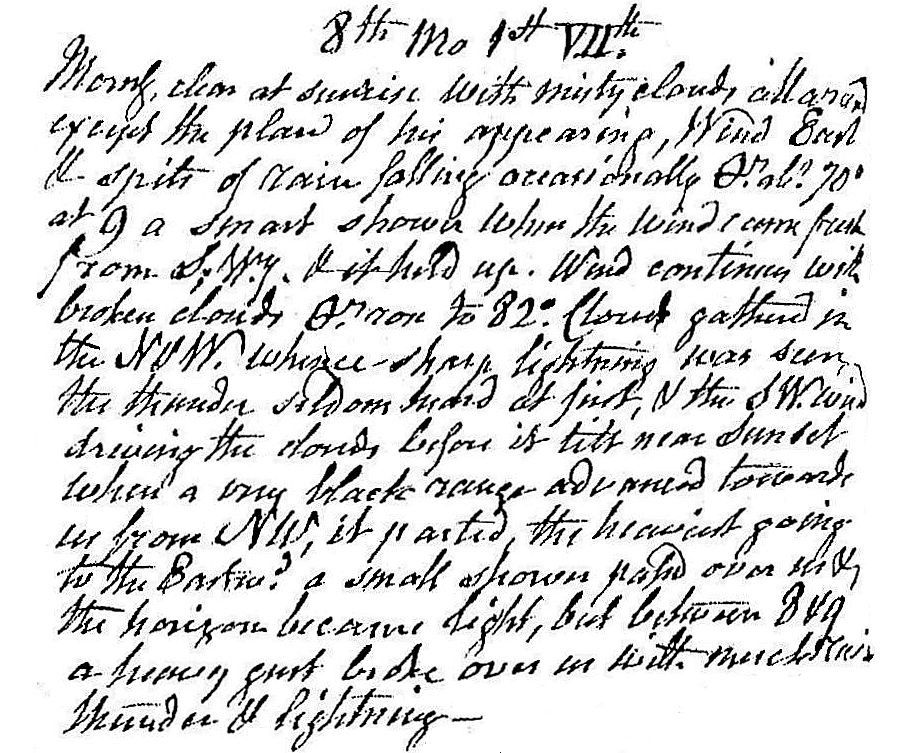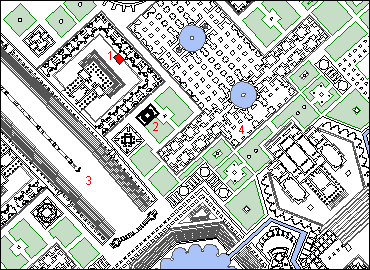1 August circa 401
Death of Maria, empress consort of Honorius.
1 August 1755
I have just dined and I have an appointment with abbé Grant to go to Piranesi's in two hours... I have just returned from my visit with Piranesi who in a month will expose my illustrious name to the world in the plan he dedicates to me which is joined in with others dedicated to Lord Charlemont an Irish Lord of great worth and character whose name is Caulfield. I will send some copies of this same work to Scotland that you may have the pleasure of seeing your Italian son's name handed down to the latest posterity, famed for his knowledge in that noble art of architecture.
Robert Adam
1 August 1778 Saturday
. . . . . .
Artifacts of the Bianconi vs Piranesi 'Circus of Caracalla' affair 1772-1789

Illustration at the head of Chapter I of Giovanni Lodovico Bianconi, Descrizione dei Circhi particolarmente di quello di Caracalla e dei Giucchi in essi celebrati.
46 y.o. Francesco Piranesi 1804
Le Antichità della Magna Grecia Parte I

Plan of the Tomb of Mamia with its dependencies in the City of Pompeii.
Drawn by G.B. Piranesi
Engraved by F. Piranesi Year 12 (1804)
1 August 1812 Saturday

Morning clear at sunrise with misty clouds all around except at the place of his appearing. Wind east and spits of rain falling occasionally, temperature about 70°. At 9 a smart shower when the wind came fresh from SWerly and it held up. Wind continued with broken clouds, temperature rose to 82°. Clouds gathered in the N and W whence sharp lightening was seen, the thunder seldom hard at first, and the SW wind driving the clouds before it till near sunset when a very black range advanced towards us from NW, it parted, the heaviest going to the eastward. A small shower passed over us and the horizon became light, but between 8 and 9 a heavy gust broke over us with much rain, thunder and lightening.
1 August 1998
Sep. Mariae Honorij Congiig.
The Sepulchrum Mariae Honorij Congiig., the tomb of Empress Maria the first wife of Honorius, is the second to last building of ancient Rome designated within the Ichnographia Campus Martius. Piranesi mistakenly represents the tomb of Maria as separate from the tomb of Honorius; Maria's death may well have been the reason Honorius erected his family mausoleum around 400. Despite Piranesi's incorrectness, the position of Maria's tomb on the large plan falls within the area of the Vatican Hill that is actually occupied by St. Peter's Basilica, thus adding some veracity to the sepulcher's location. Moreover, Maria's tomb is within a courtyard surrounded on three sides by what appear to be other sepulchers whose placement within the Ichnographia partially coincides with the necropolis still in existence under St. Peter's Basilica, which is the traditionally held burial place of St. Peter himself. Another interesting detail is Piranesi's placement of Maria's tomb directly in front of the Templum Apollonis that is attached to the Circus of Caligula and Nero. According to "The Life of Sylvester" within the Liber Pontificalis, the original St. Peter's Basilica was built "in the shrine of Apollo," thus indicating that Piranesi's placement of the sepulcher of Maria within the Ichnographia was not altogether incorrect, but rather subtly and cleverly making note of the ancient Rome's pagan to Christian inversion.

Sepulchrum Mariae Honorij Congiig. in context:
The Tomb of Empress Maria (1) is situated in front of the Templum Apollinis within a courtyard surrounded by what seem to be rows of other sepulchers. This temple precinct is between the Circus Caij et Neronis (3) and the Porticus Neronianae (4). The actual site of the tomb was most likely within the mausoleum of Honorius (2), which at one time was along what once was the spina of the Circus of Caligula and Nero.
A translation of the footnote text under the Sep. Mariae Honorij Congiig entry within the Il Campo Marzio "Catalogo":
Sepulcher of Maria wife of the emp. Honorius. From bk. 5 ch. 10 of Luca Fauno on the antiq. of Rome. "A few years ago," he says, "in the chapel of the King of France which is in the Church of S. Peter's, as the [construction] project put forth by Julius II was being implemented, a marble chest was found, which, from what was found of it, appears clearly to have been the Sepulchre of Maria the wife of the emperor Honorius. There remained nothing in it of her corpse, except for her teeth, hair and shinbones [amusingly, that's pronounced "stinky"]. From her clothes, since they were woven of gold, were recovered many pounds [your text should have "libbre'] of gold, since they were incinerated [here the text reads ambiguously: either in Antiquity, or, and I give this an edge, by the discoverers]. A silver chest was found in it a foot and a half long and one palm high, and many vases of crystal and of that material called agate, excellently worked. In addition there were there was [sic] an emerald on which a head was engraved. It is thought that the head is that of Honorius, and is worth five hundred gold sequins. There was a seal inlaid with gems, that had these letters encircling it == Maria nostra florentissim. == In addition a thin gold plate with these words in Greek, == Michael, Gabriel, Raphael, Uriel. == Among the other earrings, necklaces and other women's ornaments in this chest, there was a kind of knot of emeralds a various gems, and an ornament of pure gold, called a "rizza". Furthermore on one side there were these words extending to one palm in length: DOMINO NOSTRO HONORIO; on the other DOMINA NOSTRA MARIA. A ["sorce": mouse??] of chelidonium [almost certainly: a specific type of agate with marking like tortoise-shell]. A shell, and a cup [,] of crystal. A round gold ball very much like those you play with, that could be very easily opened, divided into two compartments like a walnut. Innumerable other gems, most of which, however, were ruined by age, yet some retained their ancient splendor as if they were new and recent."
translation: Bill Thayer
The tomb of Maria was discovered 3 February 1544.
1 August 2008
I smell a Vorläufer
According to Adam, the architectural schools of the Renaissance, Mannerist and Baroque periods had fossilised the rules and standards implicit in the masterpieces of classical Greece and Rome. These theorists, by codifying the artistic laws of the ancients, had removed the sense of freedom and liberty of expression which, in Adam's view, were essential to the creative process. In turn, this rigidity had resulted in the perpetuation of designs which were at once uninspired and monotonously heavy. "The great masters of antiquity," he wrote, "were not so rigidly scrupulous, they varied the proportions as the general spirit of their composition required, clearly perceiving that, however necessary these rules may be to form the taste and to arrest the licentiousness of the scholar, they often cramp the genius, and circumscribe the ideas of the master."
Robert Oresko
1 August 2023 Tuesday
My parents were let go by the Soviet Union late autumn 1949. Seventy-four years later, the most unwitting of atonements.
Yes, plural, for there are many levels of atonement going on simultaneously in this supersaga. V. Khlebnikov, why did I not see all the connections sooner? And this new feeling of connection at times manifests itself almost viscerally, as much as that's even possible.
|